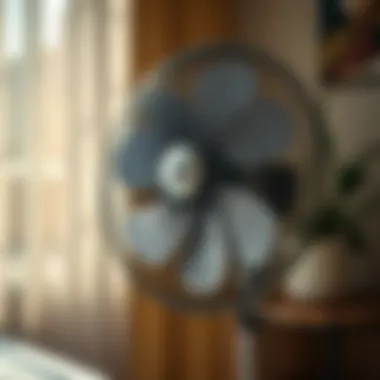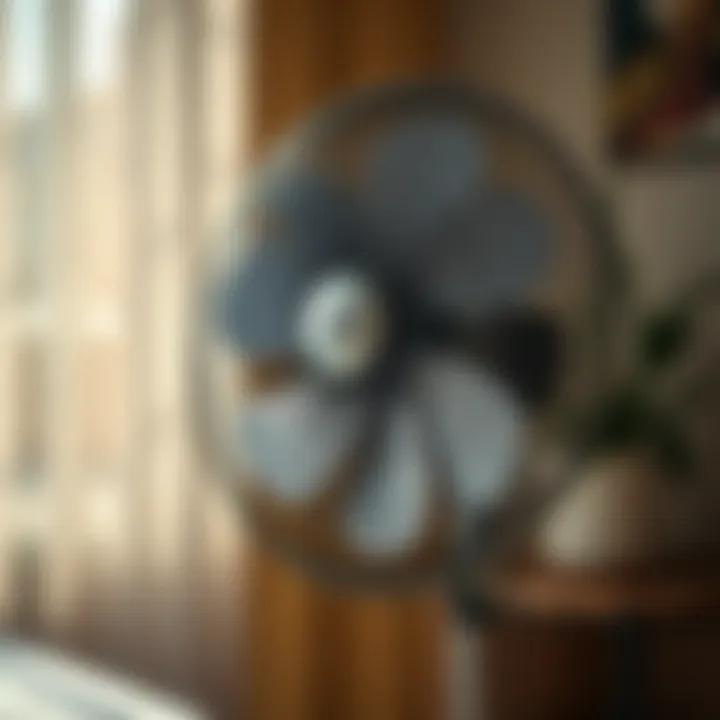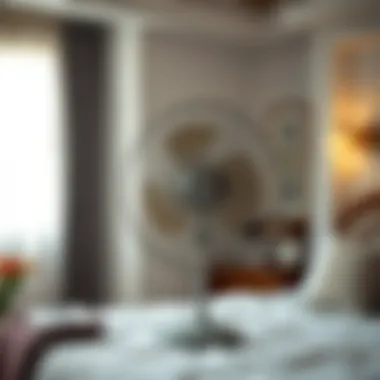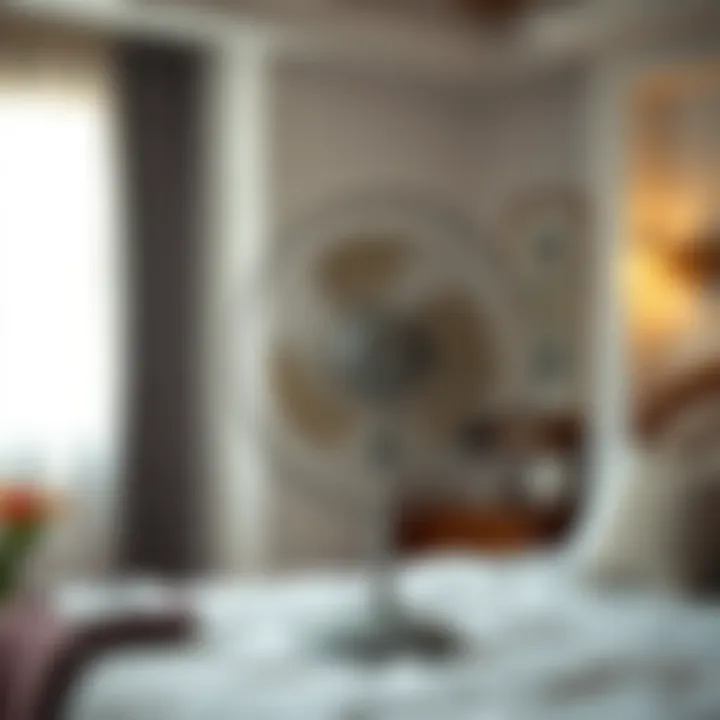Find the Best Oscillating Fan for Your Bedroom


Intro
When the temperature rises and the air feels thick, finding relief becomes a top priority. Among the various cooling solutions in today's market, oscillating fans have established themselves as a favored option for bedrooms. They offer not just a gentle breeze, but also versatility, efficiency, and an often understated charm that can complement a room’s aesthetics. This guide sets out to dissect the features worth considering when choosing the perfect oscillating fan, addressing everything from performance to style, ensuring that you’re equipped to find the model that perfectly suits your needs.
In this exploration, we dive deeply into current trends, key functionalities, and design elements, creating a holistic view of how oscillating fans can enhance both comfort and decor. Let’s unravel these details so you can enjoy a peaceful and cool night’s sleep, regardless of the weather outside.
Current Trends
Color Palettes
When selecting an oscillating fan, color shouldn’t just be an afterthought. Instead, it should harmoniously blend with your bedroom’s color scheme. Soft pastels like mint green, pale blue, or muted pink have garnered attention in recent years, gracing modern interiors with a calming effect. Alternatively, chic metallics like brushed nickel or matte black often find favor in contemporary spaces, lending an industrial feel without overwhelming the senses.
- Black: Conveys sophistication and elegance.
- White: Fresh and timeless, perfect for minimalist designs.
- Bronze and brass: Adds warmth and can serve as vintage accents.
Choosing the right hue can elevate the fan from a mere utility to a striking decorative piece.
Popular Styles
While the functional aspect of oscillating fans reigns supreme, style preferences also contribute significantly to consumer choices. From sleek, contemporary designs to retro-inspired looks, there’s something for every taste. Popular styles currently include:
- Modern Minimalism: Often defined by clean lines and simplistic aesthetics. Fans in this category typically embrace functionality while serving as artful features on their own.
- Industrial: These fans embrace rugged materials and finishes, often made from metals that amplify their raw appeal while delivering impressive airflow.
- Vintage: Fans that evoke nostalgia, featuring ornate designs and distressed finishes. Perfect for those keen on infusing character and warmth into their spaces.
The style you gravitate toward could influence not just your comfort level, but also how well the fan meshes with the overall bedroom theme. It’s fascinating how a fan can complement rather than clash with the rest of your decor, making your space not only cooler but visually appealing too.
"A good oscillating fan doesn't just cool; it creates an ambient environment that shapes your space's personality."
As we progress through this guide, we’ll delve further into the practicalities of noise levels, efficiency, and essential features to help you make an informed decision that aligns with your needs. Keep these trends in mind to ensure your selection is as stylish as it is functional.
Understanding Oscillating Fans
When it comes to comfortable living spaces, a good fan can make all the difference. Oscillating fans, in particular, are crucial in ensuring that air circulates effectively throughout any room, especially a bedroom. Their design allows for wide-reaching airflow, mitigating those pesky hot spots or stale air areas that can make even the most appealing rooms feel stuffy.
Definition and Functionality
Simply put, an oscillating fan is a type of electric fan that rotates back and forth, distributing air in a wider arc than stationary fans. This feature is what transforms an ordinary fan into a more effective cooling solution. Here’s how they work: oscillation uses a simple mechanism, typically a motor-controlled arm, that allows the fan’s head to pivot side to side. This movement enhances air circulation, ensuring that everyone in the room can feel the refreshing breeze.
The primary function of an oscillating fan extends beyond mere cooling; it can create a more pleasant atmosphere. By promoting air flow, these fans help in reducing humidity, which can lead to a more comfortable sleeping environment. On particularly warm nights, they can be a lifesaver by making it feel several degrees cooler without relying on energy-consuming air conditioning systems.
Advantages of Oscillation
There are several advantages to choosing an oscillating fan over other types of fans. Let’s take a closer look:
- Enhanced Air Circulation: Instead of blowing air in one direction, oscillating fans push air across the room, helping to maintain a uniform temperature. This can be especially important in a bedroom, where comfort is key to a good night’s sleep.
- Breeze Simulation: The motion of the fan mimics natural wind patterns, often leading to a more refreshing experience than static airflow. This gentle sway can induce relaxation, making it easier to drift off at night.
- Energy Efficiency: Operating an oscillating fan typically consumes less energy compared to central air conditioning. This can result in significant savings on electric bills, particularly during hotter months.
- Versatility: Many oscillating fans come with various speed settings and are designed for multiple room sizes, lending versatility to their use.
"In a well-ventilated room, even the warmest summer night can feel like a gentle breeze."
Understanding the mechanics and benefits of oscillating fans is an essential first step in selecting the perfect one for your bedroom. When you know how they work and the advantages they provide, you can make a more informed decision that prioritizes both comfort and efficiency.
Factors to Consider When Choosing a Bedroom Fan
Choosing the right oscillating fan for your bedroom isn't just about grabbing the first one off the shelf. It’s about ensuring that your choice enhances your sleep quality and complements your living space. Understanding the factors involved can make all the difference. When considering a fan, you’ll want to think about the balance of functionality and comfort. Here are some key elements to keep in mind.
Noise Levels
A fan that sounds like a jet engine during takeoff is hardly the recipe for a peaceful night’s sleep. Noise levels are a crucial factor when selecting your fan. Most manufacturers provide a decibel rating, but subjective experience should guide your decision. Some folks thrive on the white noise created by a fan, while others may find it distracting. Before you commit, it might be worth your while to take a test. If possible, try to hear it in a store or listen to online reviews that mention sound levels.
You can minimize disturbances if you prefer a quieter model. Look for fans that advertise whisper-quiet operation or consider those with multiple speed settings. This gives you the flexibility to dial down the sound while still enjoying the cooling effects.
Energy Efficiency
In heut times when energy bills seem to creep higher each month, choosing a fan that’s energy efficient is not just a wise choice; it’s a necessity. Fans, while not overly taxing on your electricity usage, can still ramp up your bill if they’re running all night long. Look for fans with an Energy Star label or those designed for minimal power consumption. Some oscillating fans are designed to cool while using less energy, which can help you keep your resources in check.
Additionally, some modern models come equipped with smart features that allow you to monitor energy usage from an app. This is an excellent way to track your consumption and adjust your behavior accordingly.


Size and Space Requirements
The dimensions of your room play a role in deciding which fan to purchase. A large fan in a small room can create a wind tunnel effect, leaving you far too chilly for comfort. Conversely, a small fan in a spacious area might struggle to circulate air efficiently. Before diving into the purchasing process, measure the area where you intend to place the fan and consider both height and floor space.
It’s also useful to check the oscillation range. Some fans can move their heads wider than others, which can further influence how effectively they cool the room. Don’t forget to account for furniture placement and ensure there’s adequate room for air to circulate unobstructed.
Design and Aesthetics
Let’s not skirt around the issue—appearance matters. A fan that doesn’t blend well with your bedroom decor can stick out like a sore thumb. Thankfully, many oscillating fans come in a variety of styles, colors, and finishes. Choose one that either complements your existing furniture or stands out as a statement piece.
Materials are also important in this context. Fans made from metal tend to offer a more vintage or industrial feel, whereas those crafted from plastic might lean towards modern designs. As you browse, consider how the fan will look when it's running or stationary. This way, you won’t end up with something that dampens the aesthetic of your rejuvenating space.
"A well-chosen fan doesn't just cool your room; it enhances the entire ambiance, helping you create a sanctuary for rest."
Choosing the right oscillating fan is about more than just finding something that keeps you cool. It’s a matter of finding a companion for your evenings that fits seamlessly into your life. With consideration given to noise, energy efficiency, size, and design, you'll be well on your way to making an informed decision.
Types of Oscillating Fans
When it comes to choosing the right fan for your bedroom, understanding the different types of oscillating fans is crucial. Each type brings unique benefits that cater to various needs and preferences. Knowing the options available helps narrow down what works best in your space, both functionally and stylistically.
Table Fans
Table fans are a smart choice if you're after portability and ease of use. Usually compact, they fit nicely on bedside tables or small desks without eating up valuable space.
Benefits of Table Fans:
- Portability: You can easily move these fans from room to room, or even take them along while traveling.
- Specific Airflow: They provide targeted cooling, great for a personal breeze while sleeping or working in bed. Their adjustable heads allow you to direct airflow precisely where you want it.
- Space Saver: Perfectly suited for small bedrooms, table fans blend into your decor without hogging all the room.
When you're dealing with warmer nights, a table fan can create a focused cooling effect, especially vital if you find yourself waking up from a heated sweat.
Floor Fans
If your bedroom is spacious and you want to maximize airflow, consider a floor fan. These fans are robust and often come with powerful motors that can cover a larger area.
Considerations for Floor Fans:
- Higher Air Volume: They can move more air than smaller models, making them ideal for larger spaces.
- Versatility: Most floor fans have adjustable heights and angles, providing flexibility to fit your comfort needs.
- Stability: Given their size, they are less prone to tip over compared to smaller fans.
Floor fans can double as a decorative piece while providing effective cooling. Choose a design that enhances your bedroom's aesthetic for a functional yet stylish addition.
Wall-Mounted Fans
Wall-mounted fans are a common choice for those looking to save floor space. These fans are fixed to the wall and oscillate, helping distribute cool air evenly throughout the room.
Pros of Wall-Mounted Fans:
- Space-Saving: You can keep your floor clear, making it particularly useful in tighter spaces.
- Wide Coverage: They often have a larger oscillation range, fitting well into modern design sensibilities while still offering function.
- Ideal for High Ceilings: If your bedroom has high ceilings, wall-mounted fans can effectively circulate air without taking up valuable floor space.
When you choose wall-mounted, ensure it is securely installed and away from sections of the room that may interfere with its airflow.
Smart Fans
Smart technology has reached even the world of oscillating fans. These come equipped with features that allow for remote control and even voice activation via smart home devices.
Highlights of Smart Fans:
- Remote Usage: Adjust speed, oscillation, and timers from your phone or via voice commands, making comfort easy and accessible.
- Energy Efficiency: Many smart fans come with built-in energy-saving features that help reduce electricity costs.
- Integrations: They can connect to home automation systems, allowing them to work in harmony with your other devices.
Having a smart fan can elevate not just your comfort level but also the tech-savvy atmosphere of your room.
"Choosing the right type of fan involves understanding your specific needs and space constraints. Consider how you use your bedroom and what will work best for your environment to ensure maximum comfort."
Each type of oscillating fan has its own strengths, so reflecting on what you truly need in your bedroom can lead to a more enjoyable and pleasant sleeping experience. Take your time to weigh the options and make an informed decision.


Features to Look For
When it comes to selecting the ideal oscillating fan for your bedroom, certain features can make or break the experience. Focusing on the right elements not only enhances comfort but can also contribute to energy efficiency and overall satisfaction. Selecting a fan isn't merely about aesthetics; it's about ensuring the gadget works effectively based on your unique needs.
Remote Control Functionality
In today’s fast-paced world, convenience often plays a crucial role in our daily choices. Remote control functionality in oscillating fans is one such feature that embodies this modern convenience. Imagine lying comfortably in bed, perhaps reading or simply unwinding after a long day, and with just a flick of a button, you can adjust the fan speed or oscillation without needing to get up. It sounds quite ideal, right?
Moreover, many models come with additional settings via remote controls, including timers and speed adjustments. This means you can tailor your fan’s performance to your comfort level without disturbing your tranquility. When considering a fan, look for a model with a responsive remote, so you don’t find yourself wrestling with the controls.
Adjustable Speed Settings
Another significant feature is the adjustable speed settings. The flexibility of speed settings allows you to personalize air circulation according to the temperature and humidity levels of your room. On sticky summer nights, a higher speed might be necessary to keep the air cool, while a gentler breeze could suffice during milder evenings.
Most oscillating fans typically offer at least three to four speed settings. But pay attention to how smoothly the fan transitions from one speed to another. Fans that jerk or oscillate harshly can be not only annoying but may also disrupt your sleep or downtime. Therefore, when fishing for a fan that meets your expectations, check out those adjustable speeds that provide a seamless experience.
Timer Settings
Timer settings offer a layer of versatility and efficiency that can enhance your overall fan experience. Picture this: you’re settling down for the night but wish to have the fan running only for a couple of hours as you drift off. A model with a timer can ensure the fan operates for a set duration before automatically shutting off.
This feature not only conserves energy but could also prevent overcooling the room during those cooler late-night hours. Some fans come with programmable timers that can be tailored for daily use, while others require manual adjustment. Look for intuitive timer settings that align with your habits.
Oscillation Range
Finally, another pivotal aspect to consider is the oscillation range of the fan. An effective oscillating fan should cover a broad area to provide thorough air circulation, particularly in larger rooms. Different models boast varying oscillation angles, ranging from narrower sweeps that focus airflow in specific areas to broader oscillation that disperses cool air throughout the entire room.
A fan with a wider oscillation range often means more comfort for everyone in the room. For instance, if the fan oscillates only 30 degrees, you might find it ineffective for your space, leaving some areas stuffy while others are breezy.
"The right oscillation can make the difference between a pleasant night and an uncomfortable one."
When examining oscillation ranges, remember to also consider the fan’s height and placement within your bedroom. Overall, an optimal fan not only circulates air efficiently but also complements the flow of the room.
Top Oscillating Fans for Bedrooms
Choosing the right oscillating fan for your bedroom is crucial. After all, it plays a large role not only in your comfort during hot nights but also in helping you achieve a good night's sleep. The ideal fan can influence air circulation, humidity levels, and even ambient noise, which are all factors that can make or break your nighttime routine. This section offers a detailed look into some of the best oscillating fans on the market, which can help you stay cool and cozy as you drift off to sleep.
Model Reviews
Brand A: Features and Performance
When talking about Brand A, what stands out is its sturdy design and efficient functionality. This fan is known for its ability to circulate air effectively, thanks to its powerful motor and aerodynamic blades. The key characteristic of this fan is its silent operation. This makes it a favorable choice for bedrooms where silence is golden while you’re sleeping.
One unique aspect of Brand A is its energy-efficient mode, which adjusts speed based on the room's temperature. The advantage of this feature is that it can help you save on your energy bill while keeping the room cool. However, some consumers find that its oscillation range could be limited for larger bedrooms, which may require creative positioning to achieve optimal airflow.
Brand B: Comparison Analysis
Now let's look at Brand B. This model brings a different flavor to the oscillating fan market—its self-adjusting oscillation feature means it can intuitively adjust its angle based on the user’s preference and room layout. This innovative characteristic makes it especially popular among users who prioritize customizable air circulation.
Brand B is celebrated for its robust safety features. It includes a protective grill and automatic shut-off feature, which can be quite reassuring for parents or anyone concerned about safety. On the downside, some users report that its fan speed settings might not feel distinct enough, particularly for those who like a stronger breeze.
Brand C: Consumer Feedback
Then there's Brand C, which thrives on positive consumer feedback. Users often rave about its stylish design which can blend seamlessly into various bedroom décors. A notable feature of Brand C is its remote control capability, allowing users to adjust settings without needing to get out of bed.
This fan’s high customer satisfaction score indicates that it’s both effective and reliable, benefiting from a durable build. While the price point is higher compared to others, many consumers argue its versatility and performance justify the investment. Yet, there are mentions of the botanical material used in its construction being prone to scratches, which could detract from its overall aesthetic over time.
Price Comparison
When considering oscillating fans, prices can vary widely based on brand, features, and overall quality. Here’s a brief overview of what you might expect:
- Brand A: Typically priced at around $70, offering a good balance of performance and affordability.
- Brand B: Priced higher, around $100, due to its advanced features and versatility.
- Brand C: The priciest option, beginning at around $120, is often viewed as a premium choice due to its sleek design and user-friendliness.
Ultimately, choosing the best oscillating fan for your bedroom boils down to your specific needs, preferences, and budget. Taking the time to consider these options can lead to better sleep and enhanced comfort during long summer nights.


Maintenance and Care
Proper maintenance and care of an oscillating fan are crucial for prolonging its life and ensuring optimal performance. Just like how you clean a car to keep the engine running smoothly, taking care of your fan helps maintain efficient airflow and quiet operation. Regular upkeep can prevent dust accumulation, which could lead to increased noise levels and reduced effectiveness.
Cleaning Techniques
When it comes to cleaning your oscillating fan, a few steps can make a world of difference. Here’s how to keep your fan spick and span:
- Unplug the Fan: Always start by disconnecting the fan from the power source to prevent any accidents.
- Dusting: Use a soft, dry cloth or a vacuum cleaner attachment to remove dust from the exterior. Pay special attention to the blades, as dust build-up can hinder performance.
- Blade Cleaning: For a more thorough cleaning, take a damp cloth with a bit of mild soapy water and wipe down the blades carefully. Avoid using excessive water as it can cause internal damage.
- Base and Grill: Detach the grill if possible. Clean the grill by rinsing it with warm soapy water and wiping it down. A toothbrush can come in handy for those hard-to-reach spots.
- Drying: Ensure everything is dry before reassembling the fan. This helps prevent mold or mildew growth.
Long-Term Care Tips
Taking care of your fan goes beyond cleaning. Here are a few tips to ensure your oscillating fan stands the test of time:
- Regular Inspections: Every few months, check for any loose screws or wobbly components. Tightening these can prevent malfunction and ensure safe operation.
- Lubrication: If your fan has a motor that requires lubrication, refer to the manufacturer’s guidelines. Adding lubricant can reduce wear and tear and improve efficiency.
- Storage: If the fan will not be used for an extended period, store it in a dry place to protect it from moisture and dust. Wrap it in a cloth for extra protection.
- Usage Habits: Avoid running the fan at the highest speed for extended periods. Instead, opt for a medium setting most of the time. This reduces strain on the motor.
Following these maintenance and care guidelines will keep your oscillating fan in tip-top shape, ensuring that you get the most comfort and longevity from this essential bedroom appliance.
Common Issues and Troubleshooting
When it comes to oscillating fans, understanding common issues and troubleshooting can save you a lot of frustration and money. Many people don’t consider this aspect until they're faced with a problem that disrupts their comfort during hot summer nights. This section aims to shed light on two significant areas of concern: diagnosing noise problems and dealing with malfunctions. By being aware of these issues and their solutions, you’ll be better equipped to maintain your fan’s performance and longevity.
Diagnosing Noise Problems
Let’s face it—nobody wants their peaceful sleep interrupted by strange noises from an oscillating fan. Noise issues can stem from various sources. The key is knowing how to pinpoint these problems. Here are some common culprits:
- Loose Parts: Over time, screws and other components can loosen up, causing your fan to rattle.
- Dust Accumulation: Dust can settle in some hidden corners, affecting the motor and blade movement.
- Worn-out Bearings: If you hear a grinding sound, it might indicate that the bearings are wearing out.
To diagnose noise issues:
- Inspect Visually: Turn off the fan and check for any loose screws or misaligned blades.
- Clean Regularly: Make it a habit to clean your fan, focusing on the motor housing and blades.
- Test Different Settings: Sometimes noise appears only at specific speeds, indicating a need for internal examination.
If you've inspected your fan and can't seem to locate the issue, don't hesitate to consult the manufacturer’s manual or reach out to a technician for help. It’s better to nip the problem in the bud rather than let it grow into something more significant.
Dealing with Malfunctions
Malfunctions are like unwelcome guests at a party—they can throw everything off balance. Recognizing the signs of a malfunction can spare you from further complications. Here are some common fan issues and how to tackle them:
- Fan Won't Turn On: This is a classic issue and might stem from a faulty power source. Check your outlet first.
- Limited Oscillation: If your fan isn’t oscillating properly, there might be a stuck component or a faulty motor.
- Overheating: If the fan overheats, it could indicate blockages in airflow or electrical issues.
To troubleshoot malfunctions:
- Reset the Fan: Sometimes, simply unplugging and plugging it back in can do wonders.
- Check Connections: Confirm that all wires are securely connected and aren’t frayed.
- Professional Help: If you still face problems after performing these steps, it may be time to call in a professional. Attempting extensive repairs yourself can lead to more damage.
Remember, regular maintenance is your best friend. Taking care of your oscillating fan can enhance its performance and extend its lifespan.
In summary, addressing common issues and effective troubleshooting can bear fruit in maintaining your oscillating fan. Keeping your space cool should not come at the expense of sleep interrupted by noise or worries about malfunctioning equipment. Stay ahead of the game by being proactive about these common problems.
Ending and Final Thoughts
In wrapping up our exploration of oscillating fans tailored for your bedroom, it’s essential to appreciate the multifaceted nature of this seemingly simple appliance. An oscillating fan can be more than just a device for air circulation; it can significantly contribute to the overall ambiance, comfort, and functionality of your personal space. Selecting the right fan doesn't merely hinge on aesthetics or price; it involves a thoughtful consideration of various factors such as noise levels, energy efficiency, and essential features that suit your unique lifestyle.
Summary of Key Considerations
When you're on the hunt for an oscillating fan, several key considerations come into play:
- Noise Levels: An essential aspect, especially for nighttime use, is how much sound the fan produces. A whisper-quiet fan could be the difference between a restful night and a night spent tossing and turning.
- Energy Efficiency: With energy concerns on the rise, choosing a fan that operates efficiently can offer both comfort and savings on your utility bill. Look for fans that come with Energy Star ratings.
- Size and Space Requirements: From compact table fans that take up minimal space to taller floor fans designed for larger areas, ensuring the fan suits your space is crucial for optimal circulation.
- Features: Functional elements, such as remote controls, timer settings, and adjustable speed, can enhance usability and accommodate varied needs.
- Design and Aesthetics: A fan shouldn’t just cool the air but also complement the decor of your room. Stylish designs can act as a focal point while maintaining a functional presence.
In addition to these points, it’s valuable to consider maintainability and the reliability of the models you're interested in, as the long-term performance can alter your enjoyment of the product.
Making the Right Choice
Making an informed decision about which oscillating fan to purchase is paramount. Start by establishing your priorities based on the considerations mentioned above. Think about how much time you'll spend in your bedroom, whether you need a quiet background breeze, or if you're simply after a cool-down in sweltering heat.
Compare various models not just by brand, but by customer reviews and real-world performance metrics. Utilize online forums or sites like Reddit for firsthand user experiences, which could shine light on aspects manufacturers may overlook in descriptions.
When it comes to budget, it’s advisable to balance cost with quality. A cheaper fan might be tempting but often underperforms compared to a more expensive model that promises longevity and superior function.
Ultimately, the right oscillating fan can create a soothing climate, making your bedroom a sanctuary of comfort and tranquility. Take the time to assess your needs thoughtfully and enjoy the process of choosing an appliance that will enhance your living experience.



